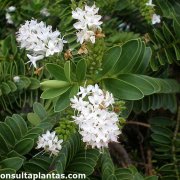Care of the shrub Hebe albicans or White hebe |
|
The genus Hebe, family Plantaginaceae, includes 90 species of shrubs native to South America, New Zealand, Australia and some Pacific islands. Sometimes the genus Hebe is included in the genus Veronica. Some species are: Hebe albicans, Hebe stricta, Hebe salicifolia, Hebe speciosa, Hebe diosmifolia, Hebe acutiflora. Common name: White hebe. This species is native to New Zealand. They are compact and rounded shrubs that reach 60 cm (23.6") in height. They have light green or bluish oval leaves arranged in graceful symmetries along the stems. The flowers are small and white but appear profusely in spikes. They bloom in summer. White hebe is used to form low hedges, in bushy margins, as isolated specimens and in pots for patios and terraces. It's highly recommended plants for Mediterranean coastal gardens. Hebe albicans can be grown in full sun or semi-shade exposure and protected from cold and dry wind. White hebe can grow in poor but well-drained soil but prefers it to contain organic matter. Planting or transplanting is done in spring or autumn. Water moderately, waiting for the surface 5 cm of the substrate to dry. In winter reduce watering a lot. Fertilize in autumn with compost or manure and mineral fertilizer every 2 weeks in the flowering season. Hebe albicans does not need pruning. White hebe is a resistant plant to the usual pests and diseases. Hebe albicans propagates by division in spring or summer and from seeds planted in a seedbed under glass in early spring. |
Images of the shrub Hebe albicans or White hebe |
Find plants
Hebe albicans or White hebe | Care and Growing
© 2025 FavThemes



